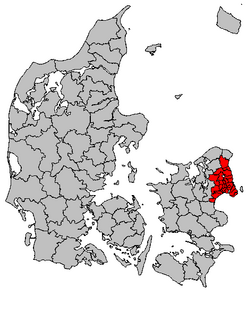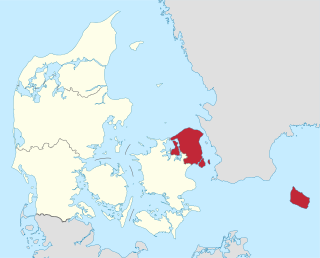
Gladsaxe Kommune is a municipality near Copenhagen in Region Hovedstaden on the island of Zealand (Sjælland) in eastern Denmark. The municipality covers an area of 25 km2 (10 sq mi), and has a total population of 69,681 (2019). Its mayor is Trine Græse, a member of the Social Democrats (Socialdemokraterne) political party.

Høje-Taastrup Kommune is a municipality in Region Hovedstaden on the island of Zealand (Sjælland) in eastern Denmark. The municipality covers an area of 78 km² (30 mi²), and has a total population of 50,676. It was formed by the 1970 Danish Municipal Reform, and its 1974 adjustment, by merging the parish municipalities of Høje Taastrup, Sengeløse, the Fløng part of Hvedstrup-Fløng and the Reerslev part of Reerslev-Vindinge. Since 1 January 2006 the mayor of the municipality has been Michael Ziegler, a member of the Conservative People's Party political party.

The urban area of Copenhagen, lying mostly in the Capital Region of Denmark but also in Region Zealand, consist of Copenhagen and Frederiksberg municipalities and the former Copenhagen County. In all, it consists of 18 municipalities, and except parts of Ballerup, Greve, Ishøj, former Søllerød and former Værløse, mentioned with their population included from 2007. Ishøj and Greve Strand are included for the first time since 1999. As of 1 January 2016, this area had a population of 1,280,371. Statistics Denmark states that the definition of the urban area is based on UN's 200m definition.

The Copenhagen S-train, the S-train of Copenhagen, Denmark is a key part of public transport in the city. It is a hybrid urban-suburban rail serving most of the Copenhagen urban area, and is analogous to S-Bahn systems of Berlin, Vienna and Hamburg. The trains connect the Copenhagen inner city with Hillerød, Klampenborg, Frederikssund, Farum, Høje-Taastrup and Køge. There are 170 km of double track with 86 S-train stations, of which eight are in neighbouring towns outside greater Copenhagen.

M1 of the Copenhagen Metro, colored green on the map, runs from Vanløse to Vestamager. It connects the Ørestad neighborhood of Copenhagen, Denmark, to the city center. The line is elevated while traveling through Ørestad, while it runs in a tunnel below the city center. From Christianshavn to Vanløse, the line is shared with M2.

The Capital Region of Denmark is the easternmost administrative region of Denmark. The Capital Region has 29 municipalities. The regional council consists of 41 elected politicians. The chairperson as of 1 January 2014 is Sophie Hæstorp Andersen. She is a member of the Social Democrats political party.

Ørestad is a developing city area in Copenhagen, Denmark, on the island of Amager.

Ørestad is a junction station served by both the Copenhagen Metro and regional trains in Copenhagen, Denmark. The penultimate stop of the M1 Line, it is located in zone 3 in the west-central section of the island of Amager.

Vestamager is a rapid transit station of the Copenhagen Metro in Copenhagen, Denmark. The terminus of the M1 line, it is located in zone 3 in the southwestern section of the island of Amager.

Glostrup station is a commuter rail railway station serving the railway town/suburb of Glostrup west of Copenhagen, Denmark.

Hedehusene is a suburban town located on the rail line between Copenhagen and Roskilde in the Capital Region of Denmark. It has absorbed the villages of Baldersbrønde and Fløng and almost merged with Roskilde's eastern Trekroner neighbourhood to the west and Taastrup to the east. To the south is the large recreational area Hedeland. As of 1 January 2021, the town had a population of 12,874. A large development project, NærHeden, created as a collaboration between Høje-Taastrup Municipality and Realdania, will expand the town to the southeast with a new sustainable neighbourhood.

Taastrup is a Danish railway town or/and suburb of Copenhagen - 15 km west of the capital's city centre, and formerly the administrative seat of Høje-Taastrup Municipality, Region Hovedstaden. It takes its name from the village of Taastrup Valby, which also gave its name to the station established in 1859, from which the town grew. The population on 1 January 2021 was 34,698. It forms a twin (sub)urban area with neighbouring suburb Høje Taastrup since the 1980s, that has engulfed the villages of Taastrup Valby, Høje Taastrup, Kragehave and Klovtofte. This area has almost grown together with the town of Hedehusene.

The Copenhagen metropolitan area or Metropolitan Copenhagen is a large commuter belt surrounding Copenhagen, the capital of Denmark. It includes Copenhagen Municipality, Frederiksberg and surrounding municipalities stretching westward across Zealand. It has a densely-populated core surrounded by suburban settlements.

Super Bikeways in metropolitan Copenhagen are a network of high quality bikeways under development to promote commuting by bicycle in metropolitan Copenhagen, Denmark. A collaboration between Copenhagen Municipality and 18 surrounding municipalities in Greater Copenhagen. The objective is to facilitate and increase commuting by bicycle.

Roskildevej is a road between Copenhagen and Roskilde in the Danish capital area. The direct continuation of Vesterbrogade, which begins at Copenhagen's City Hall Square, the road begins at Pile Allé and continues through Frederiksberg, Valby, Rødovre, Glostrup, Albertslund, Taastrup and Hedehusene to Roskilde. The section between Hedehusene and Roskilde is now known as Københavnsvej and in Hedehusene and Glostrup it is simply known as Hovedgaden.

Greater Copenhagen Light Rail is a planned electric light rail system in the Greater Copenhagen, Denmark. Its first stage is known as the Ring 3 Light Rail and went under construction in 2018. It will go from Lundtofte Park north of Copenhagen to Ishøj station in the southwest, and it is expected to open in 2025, with an annual ridership of 13-14 million projected. The line will be owned by the Ringby-Letbanesamarbejdet, which is a collaboration between the municipalities serviced or affected by the line.
Hoje or variants may refer to:
Constituencies are used for elections to the Folketing, the national parliament of Denmark. Denmark proper is divided into 10 constituencies largely corresponding to the Provinces of Denmark, each electing multiple members using open-list proportional representation. Those constituencies are then divided into 92 opstillingskredse which mainly serve the purpose of nominating candidates, but historically functioned as single-member constituencies electing one member using plurality voting.

Vestegnen is a term for a part of the former Copenhagen County, located west of Copenhagen. The area is defined as consisting of the municipalities of Hvidovre, Glostrup, Brøndby, Albertslund, Vallensbæk, Ishøj and Høje-Taastrup and covers the area around some of the stations of the S-train, which are on the lines towards Høje Taastrup and Køge, and which are within the former Copenhagen County. The urban area of Hundige is often included due to its proximity to Ishøj and the former terminus on the Køge Bugt-banen, but Hundige is located in Greve Municipality and thus neither in the former Copenhagen County nor the current Capital Region of Denmark.

















